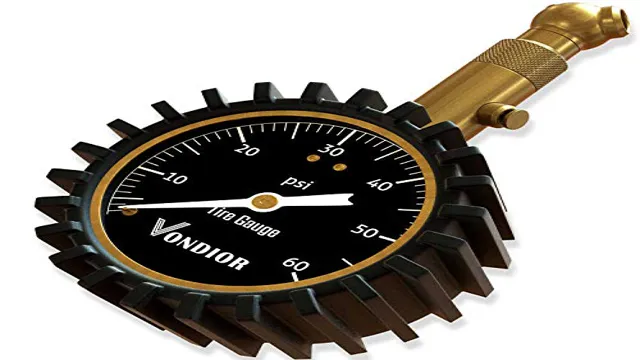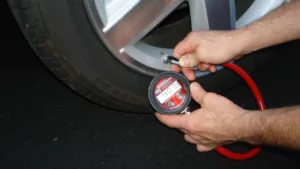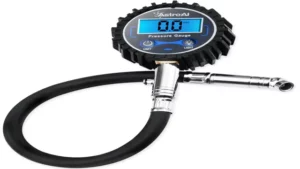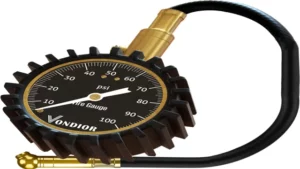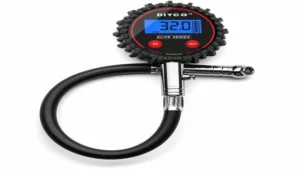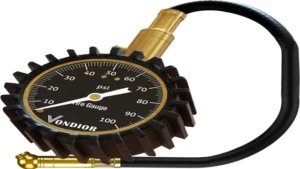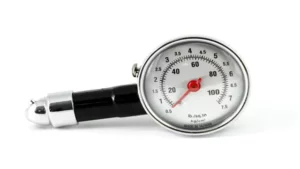Have you ever wondered how a tire pressure gauge works? As car owners, we all know how important it is to check and maintain the right amount of air in our tires. It not only ensures optimal fuel consumption but also guarantees our safety on the road. But have you ever stopped to think about the mechanism behind a simple tire pressure gauge? Well, a tire pressure gauge works on a very simple principle – measuring the amount of air pressure inside your tires.
It’s a small, handheld device that is fitted with a pressure sensor and a digital or analog display. You attach the gauge to the valve stem of your tire and apply pressure to get a reading. The tire pressure gauge measures air pressure in pounds per square inch (PSI).
When the gauge is attached to the valve stem, the pressure inside the tire forces a small rod inside the gauge to move. This movement is sensed by the pressure sensor and displayed on the small screen, giving you an accurate reading of the air pressure in your tire. It’s important to note that the tire pressure gauge only measures pressure and not volume.
It’s always best to check the manufacturer’s recommendations for your tire’s optimal pressure to ensure safety and performance. With regular checks, you can maintain optimal air pressure levels, extend the life of your tires, and enjoy a safe, smooth ride on the road.
Introduction
Have you ever wondered how a tire pressure gauge works? Well, it’s actually a simple yet effective tool that can help you ensure that your tires are properly inflated, which is essential for safety, fuel efficiency, and overall tire health. Basically, a tire pressure gauge measures the air pressure inside your tires by inserting a small metal rod into the valve stem. As the air enters the gauge, it compresses a spring that is calibrated to provide a reading on a dial or screen.
The reading indicates the pressure in pounds per square inch (PSI), which you can compare to your vehicle’s recommended pressure. If the reading is too high or too low, you can adjust the pressure accordingly using an air compressor or manual pump. Overall, using a tire pressure gauge regularly is a quick and easy way to maintain proper tire pressure, which can save you money and keep you safe on the road.
What is a tire pressure gauge?
A tire pressure gauge is a simple yet essential tool for any car owner. It is used to measure the air pressure inside your car’s tires. Maintaining proper tire pressure not only prolongs the life of your tires but also ensures your safety on the road.
With the help of a tire pressure gauge, you can quickly and easily check and adjust the air pressure in your tires. This is crucial because overinflated or underinflated tires can lead to uneven wear and tear, poor gas mileage, and even blowouts while driving. By regularly monitoring your tire pressure and keeping it at the manufacturer-recommended levels, you can ensure smooth and safe driving.
So, if you want to take good care of your car and yourself, investing in a tire pressure gauge is a must!
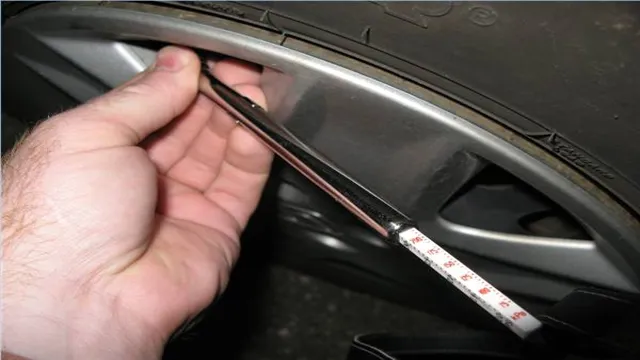
Why do you need to check tire pressure?
As a driver, one of the essential things that you need to keep in mind is to check the tire pressure regularly. It might not seem like a crucial task, but it can make a significant difference in your driving experience. Proper tire pressure ensures that your vehicle runs smoothly and efficiently on the road.
It is because underinflated or overinflated tires can lead to several problems while driving, such as increased fuel consumption, reduced tire lifespan, and decreased vehicle performance. Checking the tire pressure is a straightforward task that you can do yourself or have it done at a gas station. It is imperative to do it regularly as the tire pressure can change due to changes in temperature and driving conditions.
So, take a few minutes to check the tire pressure before hitting the road, and it will help you have a safer and more comfortable driving experience.
Types of Tire Pressure Gauges
Have you ever wondered how a tire pressure gauge works? Well, there are various types of tire pressure gauges available in the market. The most common type of tire pressure gauge is the pencil type that comes with a measured stick that pops out at the end of the gauge when pressed against the tire. Another type of tire pressure gauge is the digital tire pressure gauge that comes with a digital display and a valve stem that readings can be taken from.
The third type of tire pressure gauge is the dial type that uses a needle and dial to display your tire’s pressure reading. What all these gauges have in common is that they work by measuring the air pressure within a tire to give an accurate reading. So next time you need to check your tire pressure, remember to use the appropriate tire pressure gauge type for an accurate reading, keeping your car and yourself safe on the road.
Analog Tire Pressure Gauges
Tire Pressure Gauges When it comes to keeping your tires properly inflated, a tire pressure gauge is an essential tool. Analog tire pressure gauges are one type of gauge that has been around for many years. These gauges work by using a small, spring-loaded piston that measures the air pressure in your tire.
While digital gauges have become increasingly popular in recent years, many people still prefer the simplicity and reliability of an analog gauge. Analog gauges are also often more affordable than their digital counterparts. One thing to keep in mind when using an analog gauge is that they can be a bit trickier to read accurately than digital gauges.
It’s important to make sure you are using the gauge correctly and double-checking your readings to ensure they are accurate. Overall, an analog tire pressure gauge is a great tool to have in your car for quick and easy tire pressure checks.
Digital Tire Pressure Gauges
Digital tire pressure gauges have become increasingly popular among car owners due to their accuracy and convenience. There are several types of digital tire pressure gauges available in the market, each with its own unique features. The most basic type is a handheld gauge that is easy to use and provides quick, accurate measurements.
Another popular type is the digital gauge with a backlit screen, making it easy to read in low-light conditions. For those who want more advanced features, there are also gauges with built-in LED lights that can help detect leaks and other issues. Some digital gauges also come with automatic shut-off features and memory storage for multiple readings.
Whichever type of digital tire pressure gauge you choose, it’s important to keep in mind that regular tire pressure checks are key to maintaining your car’s performance and ensuring your safety on the road.
How Tire Pressure Gauges Work
If you’ve ever wondered how a tire pressure gauge works, it’s actually pretty simple. There are two main types of tire pressure gauges: analog and digital. An analog gauge works by using a small piston that measures the pressure of the air trapped within the tire.
This pressure pushes the piston out of its casing, and this movement is then read by a calibrated scale showing the appropriate PSI. On the other hand, a digital gauge uses a small electronic sensor to measure the pressure inside the tire. The sensor then sends this information to a digital display, usually in PSI, letting you know the precise air pressure within your tire.
Ensuring that your tires have the correct PSI is important for both your safety and fuel economy. So, investing in a reliable tire pressure gauge can be an essential part of routine car maintenance.
Mechanical Components
Tire pressure gauges are essential tools for all vehicles and enable drivers to monitor their tire pressure regularly. The gauge works by measuring the air pressure inside the tire, which is then displayed on the device’s dial in units of PSI (pounds per square inch). Low tire pressure can lead to poor fuel efficiency, reduced safety, and premature tire wear.
That’s why it is essential to check your tire pressure at least once every month. The tire pressure gauge comprises four main parts: the gauge head, the air chuck, the pressure relief valve, and the hose. When you connect the gauge to the tire valve stem, the air pressure inside the tire compresses a small spring inside the gauge, which then moves a needle on a dial or LCD screen to indicate the pressure.
Some gauges display only the current pressure, while others can store previous readings for comparison. Overall, tire pressure gauges are simple yet effective devices that help drivers maintain their vehicle’s tires’ optimal inflation, leading to better vehicle performance, safety, and fuel economy.
Measuring Tire Pressure
Tire pressure gauges are one of the most essential tools for car owners, but have you ever wondered how they work? These gauges use a small sensor to measure the air pressure inside your tires, reporting the reading to a digital or analog display. The most common types of gauges include the pencil or stick gauge, dial gauge, and digital gauge, each offering different levels of accuracy and convenience. When using a gauge, it’s important to ensure that your tires are cool and haven’t been driven recently, as the heat from driving can increase pressure and give an inaccurate reading.
By regularly checking your tire pressure and inflating or deflating as needed, you can help ensure a safer and more efficient driving experience. So, next time you’re at the gas station or car shop, don’t hesitate to check your tire pressure with the help of a trusty tire pressure gauge.
Using a Tire Pressure Gauge
A tire pressure gauge is a simple and effective tool for checking the air pressure in your vehicle’s tires. It works by measuring the force exerted by the air inside the tire against the gauge’s piston or diaphragm. When you press the gauge’s tip onto the valve stem of the tire, a tiny pin inside the gauge opens the valve, allowing the air from the tire to push against the gauge’s piston.
This force is then displayed on the gauge’s dial or digital display. It’s important to use a tire pressure gauge regularly to ensure that your tires are properly inflated, as underinflated or overinflated tires can lead to reduced fuel efficiency and even tire failure. By taking a few minutes to check your tire pressure with a gauge, you can help make sure your vehicle is safe on the road and running efficiently.
Step-by-Step Guide
Using a tire pressure gauge may seem intimidating at first, but it is actually a simple and important task for any car owner. To start, make sure your tires are cool to the touch, as hot tires can give misleading pressure readings. Remove the valve cap and press the gauge onto the valve stem firmly to get an accurate reading.
Take note of the measurement and compare it to the recommended pressure listed in your car manual or on the tire itself. If the pressure is too low, use an air compressor to add air until it reaches the correct level. If the pressure is too high, use the gauge to release some air until it reaches the correct level.
Repeat the process on all four tires and check them regularly to ensure safe and efficient driving. By regularly keeping your tires at the correct pressure, you’ll improve fuel efficiency, prolong the life of your tires, and ensure a smooth and safe ride for you and your passengers.
Conclusion
In conclusion, a tire pressure gauge is like a detective investigating the air pressure in your tires. It uses a small needle to search for clues and determine the tire’s health. The gauge’s measurements provide vital information to keep your tires from getting too deflated or overinflated, helping you avoid potential blowouts like a savvy investigator solving a mystery.
So, let the tire pressure gauge be the Sherlock Holmes of your car, solving the case of tire safety before it becomes a bigger problem.”
FAQs
What is a tire pressure gauge and why is it important to use one?
A tire pressure gauge is a tool used to measure the air pressure inside a tire. It is important to use one because proper tire pressure can improve gas mileage, tire lifespan, and overall safety while driving.
How do you use a tire pressure gauge?
First, remove the valve cap from the tire. Then, place the gauge over the valve stem and press firmly until the hissing sound stops. Read the gauge to determine the tire pressure and compare it to the recommended pressure listed in the vehicle’s owner manual or on the inside of the driver’s side door.
What types of tire pressure gauges are available?
There are three main types of tire pressure gauges: digital, dial, and stick. Digital gauges show the pressure reading on a screen, dial gauges use a needle to show the pressure on a calibrated dial, and stick gauges have a sliding indicator that shows the pressure.
Can a tire pressure gauge be inaccurate?
Yes, a tire pressure gauge can be inaccurate if it is damaged, old, or not calibrated correctly. It is important to regularly check and replace gauges to ensure accurate readings.
How often should you check your tire pressure?
It is recommended to check tire pressure at least once a month, or before any long trips. Temperature changes can also affect tire pressure, so it is important to check after extreme weather conditions.
What happens if you drive with low tire pressure?
Driving with low tire pressure can lead to decreased gas mileage, uneven tire wear, and increased risk of a blowout or tire failure. It also puts added strain on the suspension and steering components of the vehicle.
How can I maintain proper tire pressure?
Proper tire pressure can be maintained by regularly checking the pressure with a tire pressure gauge, filling tires with air as needed, and ensuring tires are rotated and balanced at recommended intervals.
